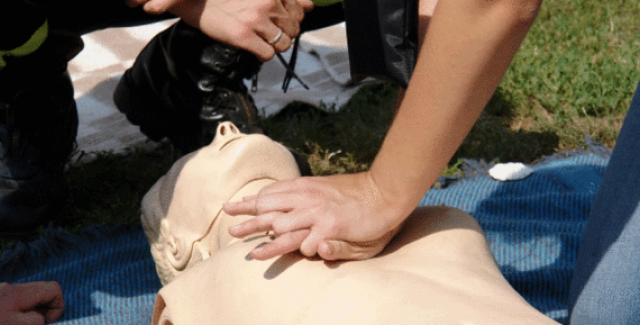Learning CPR is simple—and simply one thing we should all know.
Knowing how to perform cardiopulmonary resuscitation (CPR) means you know how to save a life. CPR is a combination of mouth-to-mouth resuscitation and chest compressions or chest compressions only, known as Compression-Only CPR. Both can restore circulation of oxygen-rich blood to the brain. Without oxygen, permanent brain damage or death can occur.
If you witness someone collapse unexpectedly, follow these steps:
Compression-Only CPR:
- Check to see if the person is unresponsive and not breathing, or breathing abnormally (struggling to breathe or gasping).
- Call 9-1-1 or direct someone else to call.
- Position the person with his or her back on the floor.
- Place the heel of one hand on the center of the chest (between the nipples) and the heel of the other hand on top of the first. Lock your elbows.
- Place your shoulders vertically above your hands and use the weight of your upper body to "fall" downward, compressing the chest 2 inches deep.
- Lift your hands slightly each time to allow chest wall to recoil.
- Compress the chest at a rate of about one hundred per minute (slightly faster than one compression per second).
- When you tire, take turns with others until paramedics arrive.
- If an automated external defibrillators (AED) is available, turn it on and follow the AED's voice instructions. If no AED is available, continue chest compressions with as few interruptions as possible.
- IMPORTANT! Struggling to breathe or gasping is not a sign of recovery! Initiate and continue chest compressions even if patient gasps.
Note: For cases of near drowning, drug overdose or unresponsiveness of young children (age 8 and under), follow conventional CPR (mouth-to-mouth). However, even in those cases, Compression-Only CPR is better than doing nothing. To learn conventional CPR, please contact the American Red Cross as www.midsouthredcross.org
Check out this great video from the American Red Cross:
Basic Adult CPR Steps:
- Call—Check the victim: Is he or she unresponsive when you talk to them? If so, call 9-1-1. Then return to the victim. In most cases, the emergency dispatcher can talk you through the CPR process.
- Blow—Tilt the head back and listen for breathing. If not breathing normally, pinch the nose and cover the victim’s mouth with yours and blow until you see the chest rise. Give 2 breaths. Each breath should take 1 second.
- Pump—If the victim still is not breathing normally, coughing or moving, begin chest compressions. Push down on the chest 1½ to 2 inches 30 times between the nipples. Pump at the rate of 100/minute, faster than once per second.
Continue with 2 breaths and 30 pumps until help arrives.
Children (1-8) CPR Steps:
Doing CPR on children is similar to doing CPR on adults. There are three differences, however:
- When compressing the chest, use the heel of 1 hand, not two hands, and press down the child's about ½ inch.
- Perform 30 compressions to 2 breaths until help arrives.
Infant CPR (Younger than a year) CPR Steps:
- Give smaller breaths just to get the chest to rise. Use only 2 fingers to compress the chest down about 1 inch.
- Follow the same sequence of 30 compressions to 2 breaths until help arrives.
Go Online for More CPR Info:
- For an online tutorial and certification through the Red Cross: www.redcrossonlinetraining.org.
- Learn more about CPR and workplace training at: www.americanheart.org.
- Need to know about pet CPR? Go to petsunlimitedblog.blogspot.com/2009/04/quick-tips-to-pet-cpr.html.






